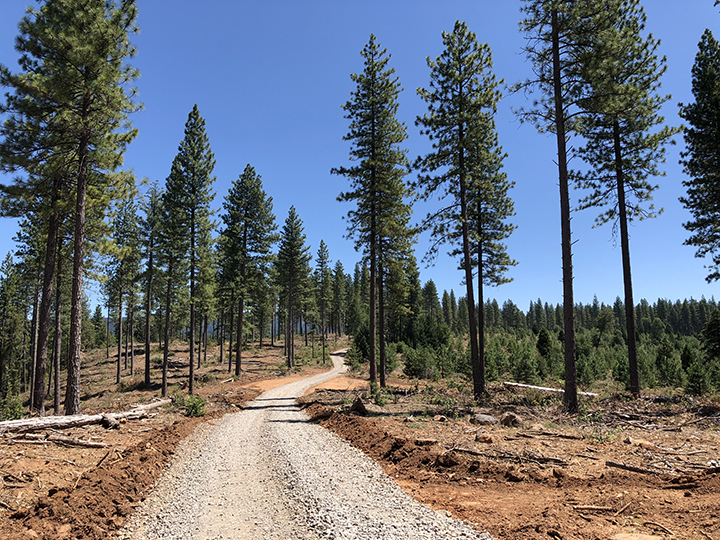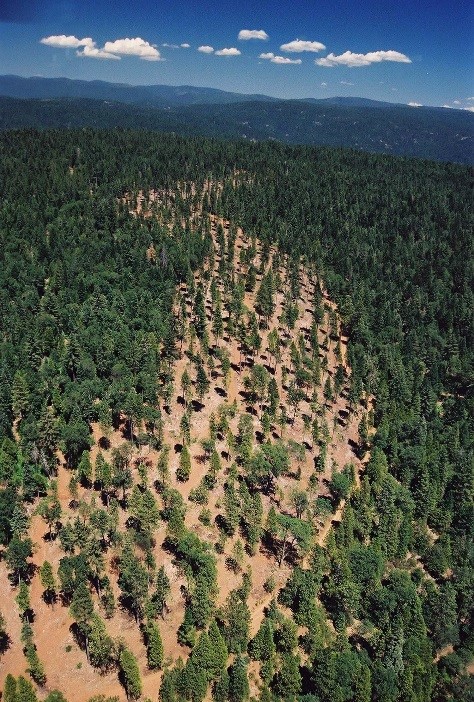By Nadine Block, Senior VP of Network Initiatives at SFI

Shaded fuel break on Sierra Pacific Industries’ California forestlands.
Sustainable Forestry Initiative (SFI) Implementation Committees (SICs) are at the forefront of local support for SFI-certified organizations implementing sustainable forestry standards. As representatives of organizations certified to SFI standards, SIC members work with state agencies, landowners, universities, and other partners to help connect forest managers with tools, training, and technical assistance to navigate fire resilience across the United States and Canada.
Since its inception in 2003, the California SFI Implementation Committee (CA SIC) has supported SFI-certified organizations in meeting SFI’s rigorous standards. Roughly 2.5 million acres in California (more than 1 million hectares) are certified to the SFI Forest Management Standard. The standard includes requirements for certified organizations to limit the susceptibility of forests to undesirable impacts of wildfire, support restoration of forests following wildfire damage, and raise awareness of the benefits of fire management.
California leads the U.S. with the most expensive wildfires by state, and this summer, like many, wildfires are top of mind. The state’s increasingly warmer and drier climate makes it especially susceptible to wildfires, and greater population density adds additional risk to people and infrastructure, creating conditions for costly damages. Over the past five years, the costs of these damages have continued to rise—more than 400%, as compared to 2000-2005, according to the California Department of Forestry and Fire Protection’s average annual fire suppression expenditure report.
The new SFI Climate Smart Forestry Initiative supports forest practices that consider local wildfire risks and their intersection with extreme weather, drought, and pests—and is aligned with the G7 Kananaskis Wildfire Charter, a commitment made in June by global leaders to collaborate on forest fire prevention and climate risk adaptation. The SFI Climate Smart Forestry Initiative works directly with experts and SFI-certified organizations to reduce greenhouse gas emissions by identifying, developing, and implementing practices that meet requirements in the SFI Forest Management Standard’s Climate Smart Forestry Objective. SFI and SICs identify and share best practices for forest management that address climate impacts to forests, wildfire risks, species and ecosystem loss, and water quality in an era of accelerating climate change.
The SFI Forest Management Standard’s Fire Resilience and Awareness objective requires SFI-certified organizations to limit susceptibility to undesirable impacts of wildfire, promote healthy and resilient forest conditions through management techniques, actions and policies, and support restoration of forests following wildfire damage. It further requires engagement in efforts to raise awareness of the benefits of fire management and minimize the undesirable impacts of wildfire, and to take action to address these important topics. While individual SFI-certified organizations are responsible for demonstrating conformance to SFI standard requirements, SICs are positioned to support coordinated, strategic, and streamlined implementation of these requirements, which will lead to greater impact through the SFI standards.

Arial view of shaded fuel break on Sierra Pacific Industries’ California forestlands.
Rosalie Fisher, Certification and Sustainability Manager at F&W Forestry and Chair of the California SFI Implementation Committee (SIC), leads annual employee training aligned with the SFI Forest Management Standard’s Objective 10: Fire Resilience and Awareness. Training incorporates F&W’s proprietary Forest Operations apps, which are designed to function offline and include a lightning detection tool that enables staff to pinpoint lightning strikes, report fires, and track suppression efforts. In California, F&W Forestry deploys a comprehensive suite of wildfire risk mitigation tools and strategies.
F&W Forestry identifies high-risk areas where treatments like fireline construction and shaded fuel breaks will be most effective in limiting the spread of wildfire and improving suppression access. To support rapid aerial response, the company has installed multiple 10,000-gallon dip tanks across its management area where natural water sources are limited. These tools—combined with trained harvest crews, drones for monitoring burn piles, advanced communication systems, and participation in regional fire cooperatives—reflect a tech-forward, landscape-scale approach to reducing wildfire risk and strengthening fire resilience.
Kevin Tuers, Forestry Services and Sustainability Manager with Sierra Pacific Industries and CA SIC Coordinator, also emphasized the importance of partnerships and preparation, “We collaborate with neighboring properties to create fuel breaks; those connections especially matter in an area with high rates of wildfire spread and tough forest conditions. Currently, creating fuel breaks and reducing fuels is very costly. Vegetation is cut, piled, and burned. Ideally, in the future, we’ll have a system where fuel reduction also becomes increasingly financially viable by using biomass to produce energy, long-lived wood products, or other innovations.”
As the 2025 summer heats up and wildfire season approaches, from large working forests to small family-owned woodlots, it’s becoming increasingly clear that fire resilience is not just an environmental issue—it is an economic and community imperative. Fortunately, there are a variety of federal, state, and local programs and tools available, and SICs are ready to connect with partners and resources to ensure forests continue to deliver critical benefits under changing conditions.
Wildfire awareness resources are available through Project Learning Tree’s (PLT) Nature of Fire Activity Collection and the “Living with Fire” activity from PLT’s Explore Your Environment: K8 Activity Guide, FireSmart Canada, Smokey Bear, Alberta’s FireSmart Guidebook for Community Protection, the Washington Department of Natural Resources’ How to Prepare for a Wildfire, and the U.S. National Interagency Coordination Center’s Potential Fire Outlook.
There’s a role for all of us to play in preparing our forests and communities for worsening wildfire seasons. Kevin Tuers with the CA SIC emphasizes the importance of investing in prevention and quick responses: “Wildfires are a reality. We have to be vigilant, educated, and prepared; shared responsibility is how we get there.”
